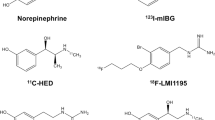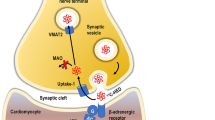Abstract
Purpose
Regional cardiac sympathetic denervation (RCSD) associated with reduced noradrenaline transporter (NAT) function has been linked to cardiac arrhythmia. This study examined the association of LMI1195, an 18F-labeled NAT substrate developed for positron emission tomography (PET) imaging, with NAT in vitro, and its imaging to detect RCSD and guide antiarrhythmic drug treatment in vivo.
Methods
LMI1195 association with NAT was assessed in comparison with other substrates, noradrenaline (NA) and 123I-metaiodobenzylguanidine (MIBG), in NAT-expressing cells. LMI1195 cardiac imaging was performed for evaluation of RCSD in a rabbit model surgically developed by regional phenol application on the left ventricular (LV) wall. The normal LV areas in images were quantified as regions with radioactivity ≥50 % maximum. Potential impact of RCSD on dofetilide, an antiarrhythmic drug, induced ECG changes was assessed.
Results
NAT blockade with desipramine reduced LMI1195 cell uptake by 90 ± 3 %, similar to NA and MIBG. NA, MIBG, or self inhibited LMI1195 cell uptake concentration-dependently with comparable IC50 values (1.09, 0.21, and 0.90 μM). LMI1195 cardiac imaging differentiated innervated and denervated areas in RCSD rabbits. The surgery resulted in a large denervated LV area at 2 weeks which was partially recovered at 12 weeks. Myocardial perfusion imaging with flurpiridaz F 18 showed normal perfusion in RCSD areas. Dofetilide induced more prominent QTc prolongation in RCSD than control animals. However, changes in heart rate were comparable.
Conclusion
LMI1195 exhibits high association with NAT and can be used for imaging RCSD. The detected RCSD increases cardiac risks to the antiarrhythmic drug, dofetilide, by inducing more QTc prolongation.








Similar content being viewed by others
References
Rundqvist B, Elam M, Bergmann-Sverrisdottir Y, Eisenhofer G, Friberg P. Increased cardiac adrenergic drive precedes generalized sympathetic activation in human heart failure. Circulation 1997;95(1):169–75.
Böhm M, La Rosée K, Schwinger RH, Erdmann E. Evidence for reduction of norepinephrine uptake sites in the failing human heart. J Am Coll Cardiol 1995;25(1):146–53.
Liang CS, Fan TH, Sullebarger JT, Sakamoto S. Decreased adrenergic neuronal uptake activity in experimental right heart failure. A chamber-specific contributor to beta-adrenoceptor downregulation. J Clin Invest 1989;84(4):1267–75.
Esler M. The 2009 Carl Ludwig Lecture: Pathophysiology of the human sympathetic nervous system in cardiovascular diseases: the transition from mechanisms to medical management. J Appl Physiol 2010;108(2):227–37.
Bengel FM, Schwaiger M. Assessment of cardiac sympathetic neuronal function using PET imaging. J Nucl Cardiol 2004;11(5):603–16.
Henneman MM, Bengel FM, van der Wall EE, Knuuti J, Bax JJ. Cardiac neuronal imaging: application in the evaluation of cardiac disease. J Nucl Cardiol 2008;15(3):442–55.
Travin MI. Cardiac neuronal imaging at the edge of clinical application. Cardiol Clin 2009;27(2):311–27.
Carrió I. Cardiac neurotransmission imaging. J Nucl Med 2001;42(7):1062–76.
Jacobson AF, Senior R, Cerqueira MD, Wong ND, Thomas GS, Lopez VA, et al. Myocardial iodine-123 meta-iodobenzylguanidine imaging and cardiac events in heart failure. Results of the prospective ADMIRE-HF (AdreView Myocardial Imaging for Risk Evaluation in Heart Failure) study. J Am Coll Cardiol 2010;55(20):2212–21.
Pietilä M, Malminiemi K, Ukkonen H, Saraste M, Någren K, Lehikoinen P, et al. Reduced myocardial carbon-11 hydroxyephedrine retention is associated with poor prognosis in chronic heart failure. Eur J Nucl Med 2001;28(3):373–6.
Podrid PJ, Fuchs T, Candinas R. Role of the sympathetic nervous system in the genesis of ventricular arrhythmia. Circulation 1990;82(2 Suppl):I103–13.
Chen LS, Zhou S, Fishbein MC, Chen PS. New perspectives on the role of autonomic nervous system in the genesis of arrhythmias. J Cardiovasc Electrophysiol 2007;18(1):123–7.
Dae MW, Lee RJ, Ursell PC, Chin MC, Stillson CA, Moise NS. Heterogeneous sympathetic innervation in German shepherd dogs with inherited ventricular arrhythmia and sudden cardiac death. Circulation 1997;96(4):1337–42.
Mitrani RD, Klein LS, Miles WM, Hackett FK, Burt RW, Wellman HN, et al. Regional cardiac sympathetic denervation in patients with ventricular tachycardia in the absence of coronary artery disease. J Am Coll Cardiol 1993;22(5):1344–53.
Sasano T, Abraham MR, Chang KC, Ashikaga H, Mills KJ, Holt DP, et al. Abnormal sympathetic innervation of viable myocardium and the substrate of ventricular tachycardia after myocardial infarction. J Am Coll Cardiol 2008;51(23):2266–75.
Stevens MJ, Raffel DM, Allman KC, Dayanikli F, Ficaro E, Sandford T, et al. Cardiac sympathetic dysinnervation in diabetes: implications for enhanced cardiovascular risk. Circulation 1998;98(10):961–8.
Boogers MJ, Borleffs CJ, Henneman MM, van Bommel RJ, van Ramshorst J, Boersma E, et al. Cardiac sympathetic denervation assessed with 123-iodine metaiodobenzylguanidine imaging predicts ventricular arrhythmias in implantable cardioverter-defibrillator patients. J Am Coll Cardiol 2010;55(24):2769–77.
Matsunari I, Aoki H, Nomura Y, Takeda N, Chen WP, Taki J, et al. Iodine-123 metaiodobenzylguanidine imaging and carbon-11 hydroxyephedrine positron emission tomography compared in patients with left ventricular dysfunction. Circ Cardiovasc Imaging 2010;3(5):595–603.
Yu M, Bozek J, Lamoy M, Guaraldi M, Silva P, Kagan M, et al. Evaluation of LMI1195, a novel 18F-labeled cardiac neuronal PET imaging agent, in cells and animal models. Circ Cardiovasc Imaging 2011;4(4):435–43.
Yap YG, Camm AJ. Drug induced QT prolongation and torsades de pointes. Heart 2003;89(11):1363–72.
Lenz TL, Hilleman DE. Dofetilide, a new class III antiarrhythmic agent. Pharmacotherapy 2000;20(7):776–86.
Mounsey JP, DiMarco JP. Cardiovascular drugs. Dofetilide. Circulation 2000;102(21):2665–70.
Buck J, Bruchelt G, Girgert R, Treuner J, Niethammer D. Specific uptake of m-[125I]iodobenzylguanidine in the human neuroblastoma cell line SK-N-SH. Cancer Res 1985;45(12 Pt 1):6366–70.
Yu M, Bozek J, Guaraldi M, Kagan M, Azure M, Robinson SP. Cardiac imaging and safety evaluation of BMS747158, a novel PET myocardial perfusion imaging agent, in chronic myocardial compromised rabbits. J Nucl Cardiol 2010;17(4):631–6.
Yu M, Nekolla SG, Schwaiger M, Robinson SP. The next generation of cardiac positron emission tomography imaging agents: discovery of flurpiridaz F-18 for detection of coronary disease. Semin Nucl Med 2011;41(4):305–13.
Yu M, Guaraldi MT, Mistry M, Kagan M, McDonald JL, Drew K, et al. BMS-747158-02: a novel PET myocardial perfusion imaging agent. J Nucl Cardiol 2007;14(6):789–98.
Nekolla SG, Reder S, Saraste A, Higuchi T, Dzewas G, Preissel A, et al. Evaluation of the novel myocardial perfusion positron-emission tomography tracer 18F-BMS-747158-02: comparison to 13N-ammonia and validation with microspheres in a pig model. Circulation 2009;119(17):2333–42.
Matsunari I, Yoneyama T, Kanayama S, Matsudaira M, Nakajima K, Taki J, et al. Phantom studies for estimation of defect size on cardiac (18)F SPECT and PET: implications for myocardial viability assessment. J Nucl Med 2001;42(10):1579–85.
Sherif HM, Saraste A, Weidl E, Weber AW, Higuchi T, Reder S, et al. Evaluation of a novel (18)F-labeled positron-emission tomography perfusion tracer for the assessment of myocardial infarct size in rats. Circ Cardiovasc Imaging 2009;2(2):77–84.
Simões MV, Barthel P, Matsunari I, Nekolla SG, Schömig A, Schwaiger M, et al. Presence of sympathetically denervated but viable myocardium and its electrophysiologic correlates after early revascularised, acute myocardial infarction. Eur Heart J 2004;25(7):551–7.
Vaidyanathan G, Zhao XG, Strickland DK, Zalutsky MR. No-carrier-added iodine-131-FIBG: evaluation of an MIBG analog. J Nucl Med 1997;38(2):330–4.
Ko BH, Paik JY, Jung KH, Bae JS, Lee EJ, Choe YS, et al. Effects of anesthetic agents on cellular 123I-MIBG transport and in vivo 123I-MIBG biodistribution. Eur J Nucl Med Mol Imaging 2008;35(3):554–61.
Raffel DM, Jung YW, Gildersleeve DL, Sherman PS, Moskwa JJ, Tluczek LJ, et al. Radiolabeled phenethylguanidines: novel imaging agents for cardiac sympathetic neurons and adrenergic tumors. J Med Chem 2007;50(9):2078–88.
Münch G, Nguyen NT, Nekolla S, Ziegler S, Muzik O, Chakraborty P, et al. Evaluation of sympathetic nerve terminals with [(11)C]epinephrine and [(11)C]hydroxyephedrine and positron emission tomography. Circulation 2000;101(5):516–23.
Glowniak JV, Wilson RA, Joyce ME, Turner FE. Evaluation of metaiodobenzylguanidine heart and lung extraction fraction by first-pass analysis in pigs. J Nucl Med 1992;33(5):716–23.
Maddahi J, Czernin J, Lazewatsky J, Huang SC, Dahlbom M, Schelbert H, et al. Phase I, first-in-human study of BMS747158, a novel 18F-labeled tracer for myocardial perfusion PET: dosimetry, biodistribution, safety, and imaging characteristics after a single injection at rest. J Nucl Med 2011;52(9):1490–8.
Minardo JD, Tuli MM, Mock BH, Weiner RE, Pride HP, Wellman HN, et al. Scintigraphic and electrophysiological evidence of canine myocardial sympathetic denervation and reinnervation produced by myocardial infarction or phenol application. Circulation 1988;78(4):1008–19.
Rimoldi OE, Drake-Holland AJ, Noble MI, Camici PG. Basal and hyperaemic myocardial blood flow in regionally denervated canine hearts: an in vivo study with positron emission tomography. Eur J Nucl Med Mol Imaging 2007;34(2):197–205.
Scholte AJ, Schuijf JD, Delgado V, Kok JA, Bus MT, Maan AC, et al. Cardiac autonomic neuropathy in patients with diabetes and no symptoms of coronary artery disease: comparison of 123I-metaiodobenzylguanidine myocardial scintigraphy and heart rate variability. Eur J Nucl Med Mol Imaging 2010;37(9):1698–705.
Tamaki N, Yoshinaga K. Novel iodinated tracers, MIBG and BMIPP, for nuclear cardiology. J Nucl Cardiol 2011;18(1):135–43.
Calkins H, Allman K, Bolling S, Kirsch M, Wieland D, Morady F, et al. Correlation between scintigraphic evidence of regional sympathetic neuronal dysfunction and ventricular refractoriness in the human heart. Circulation 1993;88(1):172–9.
Fallavollita J, Heavey BM, Baldwa S, Mashtare TL, Jr, Hutson AD, Sajjad M, et al. Volume of denervated myocardium is a novel predictor of VT/VF: prediction of arrhythmic events with positron emission tomography (PAREPET) study. Presented as a Late-Breaking Clinical Trial, May 10 at Heart Rhythm 33rd Annual Scientific Sessions. 2012.
Odaka K, von Scheidt W, Ziegler SI, Ueberfuhr P, Nekolla SG, Reichart B, et al. Reappearance of cardiac presynaptic sympathetic nerve terminals in the transplanted heart: correlation between PET using (11)C-hydroxyephedrine and invasively measured norepinephrine release. J Nucl Med 2001;42(7):1011–6.
Backs J, Haunstetter A, Gerber SH, Metz J, Borst MM, Strasser RH, et al. The neuronal norepinephrine transporter in experimental heart failure: evidence for a posttranscriptional downregulation. J Mol Cell Cardiol 2001;33(3):461–72.
Kawai H, Mohan A, Hagen J, Dong E, Armstrong J, Stevens SY, et al. Alterations in cardiac adrenergic terminal function and beta-adrenoceptor density in pacing-induced heart failure. Am J Physiol Heart Circ Physiol 2000;278(5):H1708–16.
Haider N, Baliga RR, Chandrashekhar Y, Narula J. Adrenergic excess, hNET1 down-regulation, and compromised mIBG uptake in heart failure poverty in the presence of plenty. JACC Cardiovasc Imaging 2010;3(1):71–5.
Nattel S. The molecular and ionic specificity of antiarrhythmic drug actions. J Cardiovasc Electrophysiol 1999;10(2):272–82.
Smith AH, Norris KJ, Roden DM, Kannankeril PJ. Autonomic tone attenuates drug-induced QT prolongation. J Cardiovasc Electrophysiol 2007;18(9):960–4.
Acknowledgments
Some of the data were presented at the Society of Nuclear Medicine annual meeting in 2011.
Conflicts of interest
All authors are employees of Lantheus Medical Imaging Inc.
Author information
Authors and Affiliations
Corresponding author
Rights and permissions
About this article
Cite this article
Yu, M., Bozek, J., Lamoy, M. et al. LMI1195 PET imaging in evaluation of regional cardiac sympathetic denervation and its potential role in antiarrhythmic drug treatment. Eur J Nucl Med Mol Imaging 39, 1910–1919 (2012). https://doi.org/10.1007/s00259-012-2204-y
Received:
Accepted:
Published:
Issue Date:
DOI: https://doi.org/10.1007/s00259-012-2204-y




